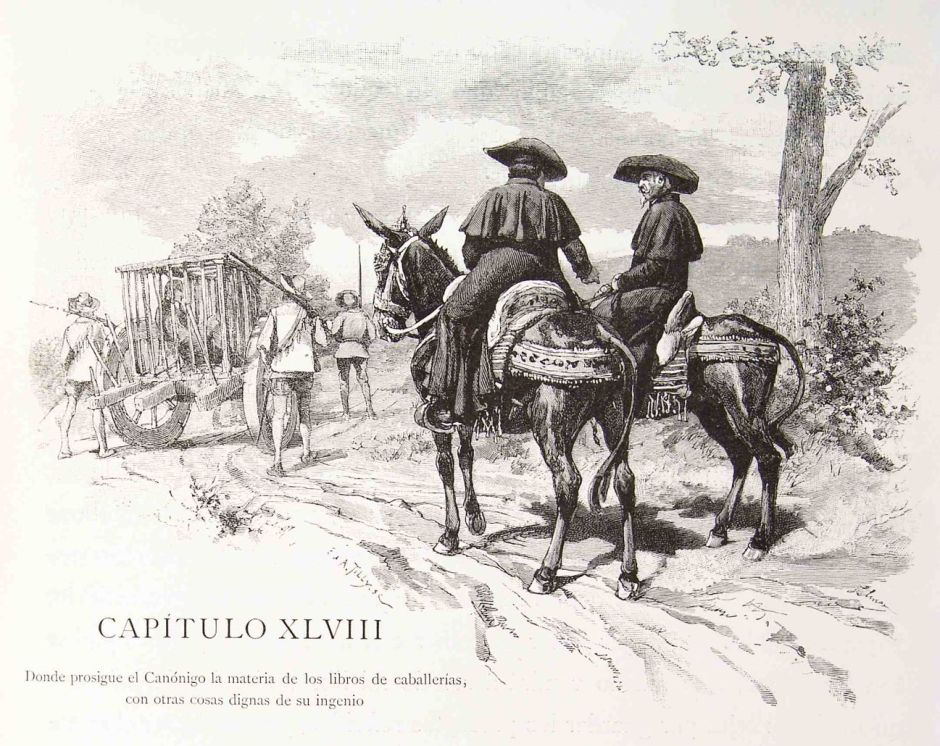In the previous episode the inn had been in chaos for much of the day. This had only worsened since the arrival of three Officers of the Holy Brotherhood, who initially intervened in the dispute over the barber’s brass basin, which Don Quixote insisted was Mambrino’s helmet. It had been the knight himself who had brought that brawl to a halt, but one of the officers realised he had a warrant for Don Quixote’s arrest, resulting from the past incident in which he had freed a chaingang of convicts. When they tried to arrest Don Quixote, he resisted fiercely, and his madness had to be explained to them. A compromise was reached in the matter of Mambrino’s helmet, and in the return of Luis to his parents. The remaining problem of how to take the knight back to his village for treatment of his madness was solved by placing the sleeping Don Quixote in a cage on the back of an ox cart.


When he had woken up fully, the caged knight expressed amazement at his position, and asked Sancho Panza how he could have allowed him to be so confined. The others could see that the captive knight was in danger of working out what was going on, so expedited his departure. The priest paid the officers of the Holy Brotherhood to accompany them, and before they left, the ladies of the inn bade their parting respects to the knight. The others too made their farewells, with the innkeeper giving the priest a copy of another story of chivalry which he had discovered among his papers.

–bal51
To maintain Don Quixote’s deception, the village priest and his friend the barber both wore masks as they rode behind the cart. They had made steady progress over the course of half a dozen miles, and were considering taking a break, when they were caught up by a group of six or seven men led by the canon of Toledo, who were keen to reach the next inn before it became too hot. As the group overtook the cart, the canon asked why Don Quixote was being taken away in a cage. An officer responded that he hadn’t the faintest idea. The knight asked them whether they understood knights errant, to which the canon replied that he was well read in that subject, and invited the knight to explain.
Don Quixote told the canon that he was being abducted by enchanters under the power of a spell. The priest confirmed that, explaining that this wasn’t for his sins, but because of the ill-will of others. The travellers were amazed, but then Sancho Panza came over and contradicted them by denying that his master was enchanted. The squire, who wasn’t aware of his master’s deception, verbally attacked the priest, revealing the latter’s identity. The barber joined in, accusing Sancho of being enchanted too.
The priest and the barber invited the travellers to move forward with them, out of earshot of the captive knight, so they could explain the long and short of the situation. The canon condemned the tales of chivalry which had brought about Don Quixote’s condition, while admitting that he too had read many of them. The priest and the canon continued to discuss the vices and virtues of those books. They blamed their authors, and the canon revealed that he’d tried to convince those who promote popular plays to put on works of art instead.

As this discussion went on, the barber rode up and pointed out to the priest that they had reached a beautiful valley which was a suitable place to take a rest. The canon decided to remain with the party conveying Don Quixote, and told some of his servants to ride on to the inn to fetch them some food. One of servants responded that their supply mule would already have reached the inn, so the canon told his servants to take the animals on ahead, and to send their supply mule back with food.


This allowed Sancho Panza the opportunity to talk to Don Quixote alone, and to explain to him the deception which the priest and barber were playing on him. Fortunately, the knight wasn’t going to be fooled by yet another ploy in the deception, and insisted that they might look like the priest and the barber, but were actually enchanters. The two fell to arguing again, in which the squire asked his master whether he needed to do number ones or twos, which brought further confusion until the knight admitted that he did, and would like to be relieved very quickly.
That completes the forty-eighth chapter of the first book of Don Quixote.
Further reading
Wikipedia
List of characters
English translation by John Ormsby (1885)
Miguel de Cervantes Saavedra, trans John Rutherford (1604, 2000) Don Quixote, Penguin, ISBN 978 0 140 44909 9.
Roberto González Echevarría (2015) Cervantes’ Don Quixote, Yale UP, ISBN 978 0 300 19864 5.
Roberto González Echevarría (ed) (2005) Cervantes’ Don Quixote, A Casebook, Oxford UP, ISBN 978 0 19 516938 6.

